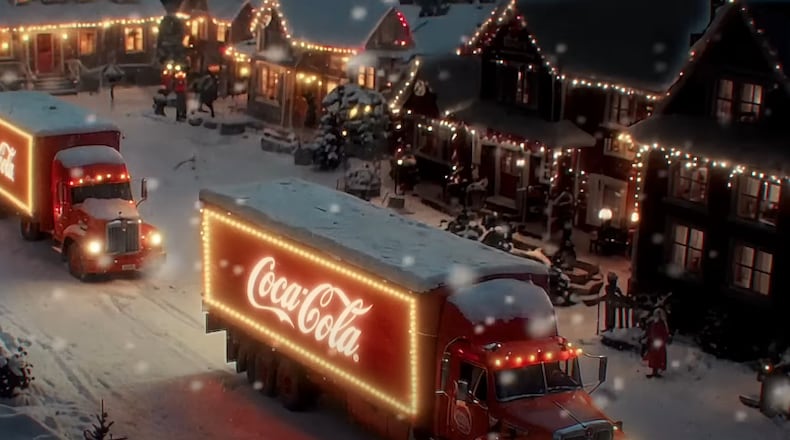For more than a century, Atlanta beverage giant Coca-Cola has released holiday ads that have closely shaped much of the imagery associated with Christmas. Think Santa Claus and polar bears.
This year, some of Coca-Cola’s holiday ads airing on TV look a little different. They’re generated by artificial intelligence.
In what is the company’s largest push into using AI in advertising, Coca-Cola partnered with generative AI companies to make new iterations of its classic 1995 ad “Holidays Are Coming.” Shots of lighted Coca-Cola trucks on snowy roads and mountains, smiling townspeople and Christmas trees rising above an idyllic village, among other familiar holiday imagery, were all rendered using AI models.
In a statement, a spokesperson for Coca-Cola said the company is “always exploring new ways to connect with fans and experiment with different approaches” and dedicated to “creating the highest level of work at the intersection of human creativity and technology.”
Silverside AI, one of the firms commissioned by Coke, provided further detail about the project on their website.
A project of the same scale as the holiday ad would typically take more than 12 months, Silverside wrote on its website. But using both proprietary technology and market AI tools, Silverside produced the ad in two months with a team of 40 people, “showcasing that AI, combined with human creativity, can elevate storytelling to new heights.”
The campaign immediately received backlash, with critics saying the ad deceives consumers and strips the holiday campaign of its creativity. On the other side of the spectrum, some called it a bold innovation and a new approach to visual storytelling.
The controversy indicates that the argument over advertisers incorporating AI into campaigns is far from settled.
Tim Halloran, a professor at Georgia Tech who spent 10 years working with Coca-Cola’s brand management division, said the new ad campaign was a violation of Coca-Cola’s brand promise.
“As a brand, you always want to establish a relationship with consumers built on authenticity and realness and being true. That’s where the fallacy of this is, especially for a brand like Coca-Cola. For years, a core crux of that brand has been the idea of authenticity. After all, Coke was ‘The Real Thing,’” Halloran said, referring to the brand’s iconic campaign from the 1970s.
To keep up with the pace of innovation in an ever-changing advertising market, Coca-Cola, along with thousands of other companies, are reckoning with the fast-improving technology. Generative AI can automate time-consuming or labor-intensive tasks involved in producing ads, cutting down on time and costs. But there are concerns it has the potential to limit the need for human workers involved in the craft.
In a study gauging awareness and acceptance of AI within the advertising industry by Yahoo and public relations company Publicis Media from earlier this year, about 77% of surveyed advertisers had a positive sentiment toward AI. Consumers only had a 38% positive sentiment.
The holiday ads are not Coca-Cola’s first foray into using generative AI. In 2023, the company debuted a tool built partly by OpenAI that generates artwork from imagery within its archives. Later that year, it allowed users to generate holiday cards.
To the untrained eye, the computer-generated graphics may look identical to real images. But it has the uncanny look of much of the AI-generated content that has flooded the internet in recent years. Halloran, who played the ad in front of his graduate students not long after it had released, said it looked like a poorly done version of the 2004 animated film “The Polar Express,” which was the first film shot entirely using motion capture technology.
The problem with AI, Halloran said, is that it can’t replicate human emotion, an element that makes so many advertising campaigns successful, Coca-Cola’s holiday ads included. Consumers typically look forward to Coca-Cola’s yearly ads and think back to older campaigns with nostalgia.
To use this campaign as its largest-scale experimentation with AI yet seems to be a statement, Halloran said.
“A brand like Coke needs to have one foot in being technologically savvy and understanding how technology is changing,” Halloran said. “You don’t want to seem baked in the past, but you have to stay true to what the brand means to people.”
About the Author
Keep Reading
The Latest
Featured




